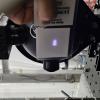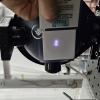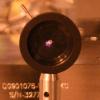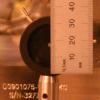Sheila, Betsy, Keita, Camilla. Continuing from 79373. Measured in 2021 in the lab in 59410.
Betsy and Sheila set up of the power meter in location B of 79373 with the wave-plate rotated such that the beam is visible. Distance between OM1 and retro-mirror is ~350mm, before the fast shutter.
The retro-refection wasn't perfect. Betsy and Sheila found that the HAM5 iris centered on the forward aux laser isn't well centered on the beam retro-reflected from the mirror in HAM6. This made it hard to block the ghost beam (direct reflection, no change in polarization) without also blocking the retro-beam that we want to measure. There is also a bright rejected beam headed to ZM6 which is only there as the waveplate is changing polarization is making some of the beam rejected by the TFP. They touched the retro mirror to improve it.
They alternated power measurements from position B (the beam that should be isolated by the OFI) and then position A (to measure the power from the laser). Used 10 seconds of statistics mode data for each with the Thorlabs power meter.
Starting measurements at 10:01 PT:
- Position B (isolated by the OFI): 1) mean 1.025uW stdev 25.55nW, Blocked/Background 809.0nW stdev 2.227nW, 2) mean 1.056uW stdev 12.11nW, Blocked/Background 845nW stdev 8nW, 3) mean 1.015uW stdev 1212nW, Blocked/Background 822nW stdev 4nW
- Position A (power from the laser): 1) mean 7.589mW, stdev 96.83uW. Blocked/Background 685.7nW stdev 12nW 2) mean 7.708mW, stdev 41.13uW 3) mean 7.742mW, stdev 47.93uW
Similar measurements by LLO in 58791 and 2021 from LHO in lab 59410.
The mean isolation measured is: -42.69dB This is well within our requirements of -36dB
AS_C sees this beam, measuring 360uW. It is not centered, -0.4 in Pit and -0.4 Yaw, see attached. When we set up the aux laser it was also off in this direction (-0.6, -0.6) 79300: similar enough.
Betsy and Shieal added a waveplate before the OFI in the AUX path and checked that the forward KTP rejected beam to OFI_B was seen, attached.
In parallel, we turned on the SQZ laser and checked that the SQZ dither lock was stable (0.94mW on OPO_IR_PD) with 75mW of SEED injected. Keita and I opened SQZT7 and adjusted ZM4 and ZM5 to be better centered on the irises. We still didn't have much beam on AS_C but after I further adjusted ZM4 (sdf's not saved), we could see it, see attached.
Betsy is working on replacing the osem magnet I knocked from it's correct position in 79316.
Daniel, Sheila, Camilla. We checked that when we turned the OFI TEC control off (before venting) the "room temp" of the chamber is 21.1 deg. WE might not be able to get this low with the TEC on but will plan to run the OFI TEC closer to 22deg than 25deg once back up.
Retro reflected beam should have been ~80% of the size of the IFO beam in the OFI.
According to Sheila the retro mirror was placed ~35cm downstream of OM1 (between OM1 and OM2). Using this number and the measured beam size of the AUX laser in the lab, the beam width of the AUX beam forward (green) and back (blue) propagating beam are plotted in the attached together with the IFO beam size. In this plot, x axis would be zero at OM1.
As a visual aid, I drew the central 18" part of the OFI cage in the HAM5 drawing. On the plot, again as a visual, aid, this 18" range is drawn as two vertical lines. All optical components of OFI should be in this 18" range, FYI they are all mounted on a single 16"-long metal plate (D2000043) though I don't know the position of that plate relative to the cage.
















































































